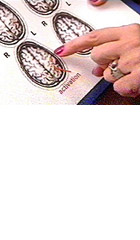
A Disease Called Pain 2003
Distributed by Fanlight Productions, 32 Court St., 21st Floor, Brooklyn, NY 11201; 800-876-1710
Produced by Vishnu Mathur for the Canadian Broadcasting Corporation
Directed by Vishnu Mathur
VHS, color, 45 min.
Jr. High - Adult
Health Sciences, Psychology, Disability Studies
Date Entered: 11/09/2018
Reviewed by Charles J. Greenberg, Cushing/Whitney Medical Library, Yale UniversitySome consumer health topics lend themselves to experiential journeys by others. Few of us embark on a path to experience chronic pain, yet all of us have faced unexpected challenges from acute onset of unwelcome, sometimes excruciating sensation, as well as straightforward pain management with analgesics or localized anesthesia.
Unlike the average acute care situation, chronic pain remains oppressive and inhibits normal lifestyle for months or years after the physical horror of initial trauma has disappeared. Chronic pain is so individualized in experience that medical science has only recently prioritized research efforts and funding to discover and replicate effective interventions to improve quality of life. A Disease Called Pain covers considerable ground in educating both a general and professional rehabilitation audience about pain origins and contemporary interventions, using the stories of authentic patients and several groups of medical experts that participated in the design of each patient’s diagnosis, therapy, and rehabilitation.
The film’s first scenario begins with the self-narrated recollections of a traffic accident victim who subsequently developed fibromyalgia, a disorder characterized by muscle pain, stiffness, and fatigue. Part of the education she provides the audience is persistence in seeking a proper diagnosis and eventually finding appropriate treatment. The film director maintains audience engagement by introducing second and third patients with their own onset story to tell.
The parents of an apparently active 13-year-old teen recount the unremitting neuropathic pain he has experienced all his life, the result of early onset chronic spinal degeneration. The stark lesson in this youth’s portrayal is that even the best pain management techniques may not halt or cure the condition that generates pain.
The third patient, a father and head of household, recounts with his wife the accidental fall that triggered a peculiar circumstance of pain in one leg and absence of all sensation in the other leg. As in the case of the film’s first subject, the absence of external physical trauma initially led to ineffective diagnoses of psychosomatic causality, as if his suffering was a function of his imagination. Eventually, after locating sympathetic clinicians with better experimental tools, this subject’s painful condition responds to an implant device designed to stimulate spinal neuron cells. Besides the alternating views of the three main subjects and their diagnostic and therapeutic trials, additional commentary is provided by several medical specialists that present insight into neuropathic injuries, pain control theories, genetic research, and cognitive science that addresses pain’s effect on thought processes. A brief segment also addresses research to update misconceptions about pain sensitivity in newborns and helping infants to cope with painful situations.
Considering the unfortunate circumstance of chronic pain and difficulty of getting timely or accurate diagnoses, the film’s most important message is hope. With perseverance and a realization that one must create the condition to become healthy, none of these patients give up. Once they make up their mind that that is indeed what then must do, they each discover a great feeling of strength emanating from within.
Considerable care is demonstrated in exhibiting authentic patient and healthcare settings. Film and sound production qualities are clearly up to the standard of the Canadian Broadcasting Corporation’s Nature of Things television series, which formed the basis for the production and initial viewing. Nature of Things host Dr. David Suzuki offers a brief introduction and conclusion to the presentation. Having heard Dr. Suzuki in-person, arguing against ineffective conventional medicine, I believe that he would want this video message of hope for chronic pain sufferers and their families to find a place in as many libraries as soon as possible.
Highly recommended for secondary, academic and public library collections on critical care medicine, consumer health, and the mind-body connection.